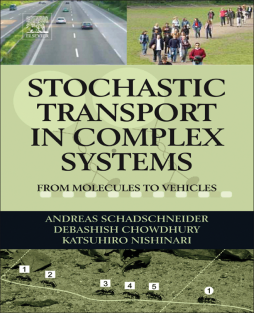
BOOK
Stochastic Transport in Complex Systems
Andreas Schadschneider | Debashish Chowdhury | Katsuhiro Nishinari
(2010)
Additional Information
Book Details
Abstract
The first part of the book provides a pedagogical introduction to the physics of complex systems driven far from equilibrium. In this part we discuss the basic concepts and theoretical techniques which are commonly used to study classical stochastic transport in systems of interacting driven particles. The analytical techniques include mean-field theories, matrix product ansatz, renormalization group, etc. and the numerical methods are mostly based on computer simulations. In the second part of the book these concepts and techniques are applied not only to vehicular traffic but also to transport and traffic-like phenomena in living systems ranging from collective movements of social insects (for example, ants) on trails to intracellular molecular motor transport. These demonstrate the conceptual unity of the fundamental principles underlying the apparent diversity of the systems and the utility of the theoretical toolbox of non-equilibrium statistical mechanics in interdisciplinary research far beyond the traditional disciplinary boundaries of physics.
- Leading industry experts provide a broad overview of the interdisciplinary nature of physics
- Presents unified descriptions of intracellular, ant, and vehicular traffic from a physics point of view
- Applies theoretical methods in practical everyday situations
- Reference and guide for physicists, engineers and graduate students
"The book is devoted to traffic and traffic-like collective phenomena. It starts with an overview of the basic techniques of modeling in the language of nonequilibrium statistical mechanics and nonlinear dynamics of interacting particles and fluids. Especially the traffic-like systems which are considered in the present book are mainly concerned with purely classical transport phenomena and quantum mechanics doesn’t play any role in these processes. In Chapter one, a classification of nonequilibrium phenomena is given, as well as a hierarchy of description. The authors distinguish the models into two categories, the individual based models and the population based models… The book gives a well balanced overview of different approaches, theories and methods on a variety of problems both old and new, of international interest. It is of particular interest as a reference for both graduate courses and seminars as well as for library collections." --Zentralblatt Math
"The book is encyclopaedic and contains a lot of information which might be very useful for graduate students and researchers new to the field… One can use it to learn the fundamentals of nonequilibrium statistical mechanics and stochastic processes, or to learn about many fundamental conceptual models and ideas, including numerical methods and algorithms that no doubt go beyond the applications considered in the second part of the book…. Finally, the book ends with an excellent guide to the literature, which points out and explains the main references, lest the reader be lost in the forest of the bibliography. The latter contains more than 1500 references, and is no doubt very complete…. The encyclopaedic character of this monograph, containing much useful information concerning techniques, methods, and models of traffic phenomena at large, makes it an important reference for young researchers and interested graduate students, as well as other scientists interested in the methods and techniques useful for applications in complex systems sciences." --Contemporary Physics
